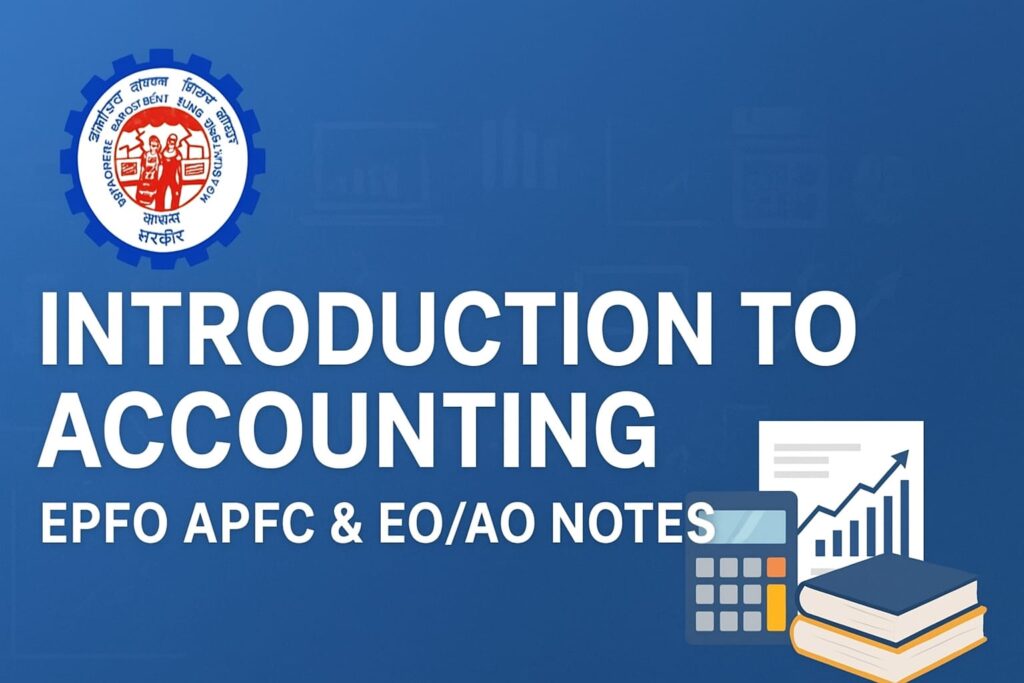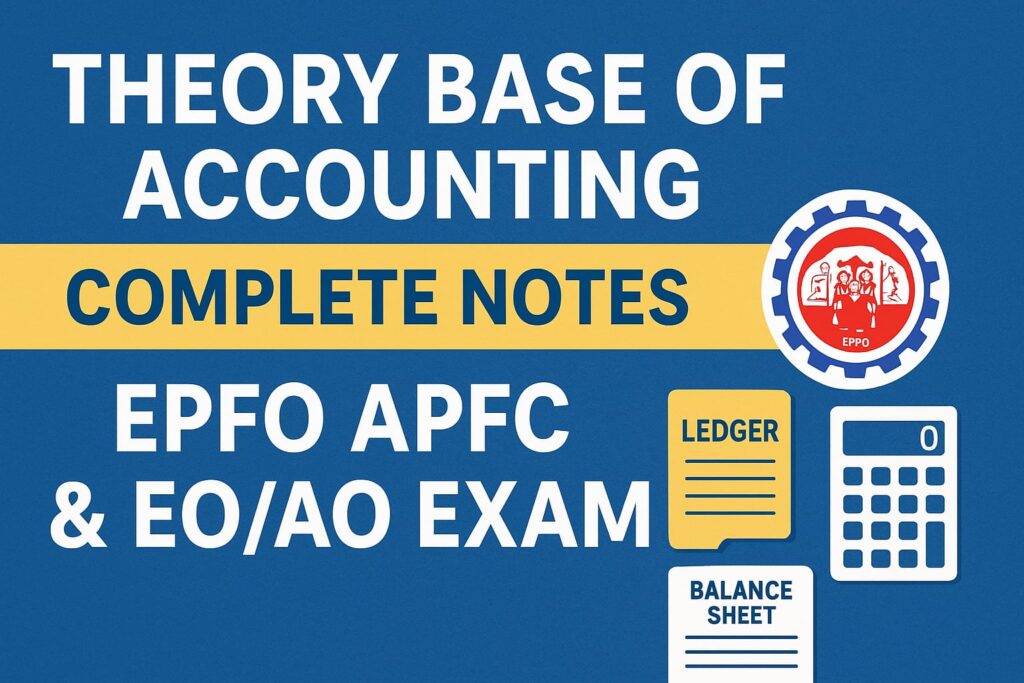If you are preparing for the EPFO APFC or EPFO EO/AO examination, understanding the basics of accounting is absolutely essential. Accounting forms a significant part of the syllabus under the “General Accounting Principles” section and is one of the most scoring areas if your fundamentals are strong.
This comprehensive guide covers all the key accounting concepts you need for EPFO – explained in a clear and simple manner – so you can revise quickly and confidently.
📊 What is Accounting?
Accounting is often called the language of business. It is the systematic process of identifying, measuring, recording, and communicating financial information related to the activities of an organization.
Every organization – whether it’s a small shop or a large company – needs accounting to keep track of its income, expenses, assets, liabilities, and profits. Accounting provides the financial data required for decision-making, performance analysis, and future planning.
For example:
To find out total annual sales – accounting provides the data.
To calculate profit or loss – accounting records income and expenses.
To plan future investments – accounting reveals financial health.
💰 Economic Events – The Basis of Accounting
Accounting records only economic events — those that can be measured in monetary terms.
Types of Economic Events:
1. Internal Events: Occur within the organization.
Example: Transfer of raw materials from stores to production.
2. External Events: Occur between the organization and external parties.
Example: Sale of goods to a customer, payment of rent to a landlord.
Events that cannot be expressed in monetary terms (e.g., change in policy, employee morale) are not recorded in accounting.
🔄 Four Steps of the Accounting Process
Accounting follows a structured process consisting of four main steps:
1. Identification: Recognizing which events are financial and should be recorded.
Example: Paying salary is recorded, but hiring a manager is not.
2. Measurement: Expressing these events in monetary terms.
Example: ₹10,000 salary payment is measurable and recorded.
3. Recording: Entering transactions in books of accounts in chronological order.
Example: January transactions are recorded before February ones.
4. Communication: Presenting financial data through reports and statements to users (e.g., management, investors, government).
✅ EPFO Exam Tip: Remember the order – Identification → Measurement → Recording → Communication.
👥 Users of Accounting Information
Accounting information is used by various stakeholders for decision-making. They are broadly classified as:
Internal Users: Managers, employees – use accounting data for planning and control.
External Users: Investors, creditors, government, customers – use it to evaluate performance and make decisions.
🔁 Flow of Accounting Information
The accounting process follows a logical flow:
1. Identify economic events
2. Measure them in monetary terms
3. Record them systematically
4. Communicate information through statements
5. Users interpret and make decisions
This ensures that raw transaction data becomes meaningful financial information.
📚 Branches of Accounting
Accounting has three main branches. EPFO questions often test your understanding of these:
1. Financial Accounting
Focus: Recording transactions and preparing key financial statements:
Income Statement (P&L): Shows revenue, expenses, profit/loss.
Balance Sheet: Shows assets, liabilities, and equity.
Cash Flow Statement: Shows cash inflows and outflows.
Used by external stakeholders like investors and shareholders.
2. Cost Accounting
Focus: Calculation and control of production costs.
Helps in fixing selling prices and managing expenses.
Mainly used for internal decision-making.
3. Management Accounting
Focus: Providing data for managerial decisions, budgeting, pricing, forecasting, and performance evaluation.
Supports strategic planning and business growth.
📈 Qualitative Characteristics of Accounting Information
For accounting information to be truly useful, it must possess the following characteristics:
Reliability: Must be free from bias and accurately reflect transactions.
Relevance: Must be timely and influence decision-making.
Understandability: Must be clear and easy to interpret.
Comparability: Should allow comparisons over time or with other businesses.
Consistency: Should use the same methods over time for meaningful analysis.
Verifiability: Must be confirmable by independent examination.
✅ Quick Tip: Use the acronym RRUCCV to remember these for the exam.
🎯 Objectives of Accounting
Accounting serves several important objectives in any business:
1. Maintenance of Records: Systematic recording of all financial transactions.
2. Calculation of Profit and Loss: Helps determine whether the business earned profit or incurred loss.
3. Depiction of Financial Position: Shows assets, liabilities, and overall financial health through the balance sheet.
4. Providing Information to Users: Supplies data for decision-making to both internal and external stakeholders.
📘 Basic Terms in Accounting (Frequently Asked in EPFO)
Term Meaning Example
Assets Resources owned by the business with monetary value. Cash, Machinery
Fixed Assets Long-term assets used for more than one year. Building, Plant
Current Assets Assets convertible into cash within one year. Cash, Stock
Liabilities Obligations or debts payable in the future. Loans, Creditors
Current Liabilities Obligations due within a year. Bills payable
Non-current Liabilities Obligations due after a year. Long-term loan
Capital Owner’s investment in the business. ₹5,00,000 invested
Sales Revenue from goods or services sold. Cash or credit sales
Creditors People/entities to whom the business owes money. Supplier
Debtors People/entities who owe money to the business. Customer
✅ Exam Tip: Creditors are those the business has to pay, while debtors are those who have to pay the business.
📌 Key Takeaways
Accounting is the language of business and follows four main steps: Identify, Measure, Record, Communicate.
Only economic events measurable in money are recorded.
Internal and external users rely on accounting information for decision-making.
There are three main branches: Financial, Cost, and Management Accounting.
Qualitative features like Reliability, Relevance, Understandability, Comparability, Consistency, and Verifiability make information useful.
Understanding basic terms like assets, liabilities, capital, sales, creditors, and debtors is crucial for the exam.
🏁 Final Thoughts for EPFO Aspirants
Accounting is one of the most scoring subjects in the EPFO APFC and EO/AO exams. Most questions are conceptual and definition-based, focusing on your understanding of fundamentals rather than complex calculations.
By regularly revising these core topics, solving previous year papers, and connecting concepts with real-life examples, you can easily master this section and improve your overall score.
A strong command over accounting will not only help you in the written exam but also give you an edge in the interview stage, where conceptual clarity often makes the difference.
Keywords: EPFO APFC accounting notes, EPFO EO/AO accounting basics, Introduction to accounting for EPFO exam, accounting


